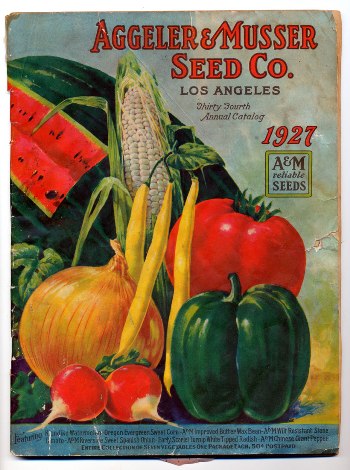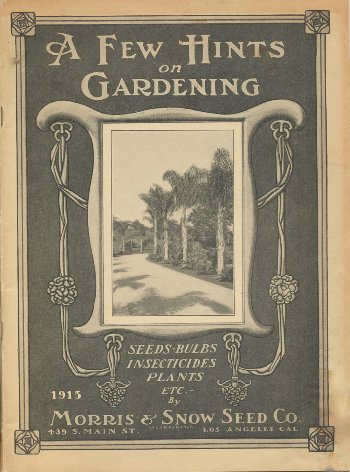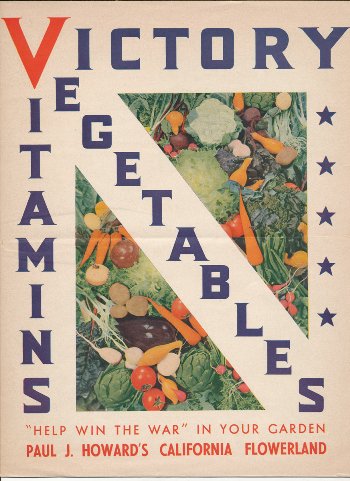Early Fruit & Vegetable Seed Catalogs of Southern California: 1888 – 1945
 |
 |
 |
Since there has been a renewed interest in home fruit and vegetable gardening, we thought we’d look back at some of the old southern California seed catalogs from our library.
California’s Horticultural History
Horticulture is as important to California’s history as the Spanish Missions and the Gold Rush. The Spanish missionaries brought with them many fruits and vegetables from Europe to California and planted several orchards. When the Gold Rush brought a population explosion in the mid 1800s, so did the demand for vegetables as miners started to develop scurvy from their meat-heavy diets. Farms were quickly established and made huge profits. In 1854 the State Agricultural Society was formed, and by 1870 over 57,000 people were making a living through agriculture (Roske, 259). By the end of 19th century California had established itself as an agricultural empire. Pioneers seeking the promise of riches through gold mining also discovered the promise of a fruitful land.
In Everyman’s Eden, Ralph Roske explains,
By 1859, market garden produce had already passed the one million dollar mark in value. During these early years, vegetable production, except for potatoes, was almost entirely for local consumption. Numerous market gardens ringed California’s larger cities. With the coming of the railroad and refrigerated freight cars, by 1879 California vegetables reached Cheyenne and Denver nearly twelve months of the year. By 1881 steamers were carrying California vegetables to British Columbia, Washington and Central America. As a result of these wide markets, vegetable production moved out of the market-garden stage. By 1899, the value of California vegetables had reached nearly six million dollars (397).
While vegetable growing proved to be a lucrative industry, fruit growing was even more profitable. An 1893 report from the Transactions of the California State Agricultural Society reported that fruit growing was the chief industry. Growing citrus, figs, grapes olives, and prunes was not possible anywhere else in all of America or Europe (110). In particular, Southern California soon established itself as a citrus empire with over 170,000 acres of citrus by the 1930s (Sackman, 7).
Southern California’s mild climate was the perfect environment to raise fruits and vegetables and it was heavily promoted as an earthly paradise. As scores of people came to the area in the late 1800s and early 1900s to profit from such an Eden, many nurseries had established themselves in order to service them. They promoted the growing of citrus orchards, avocados, berries, lettuce, rhubarb, and everything in between. They appealed to both the large-scale farmer and the home gardener offering advice on what crops to grow and when and what items to plant in your victory garden.
This exhibit highlights some of the fruits and vegetables offered in southern California nurseries’ catalogs from the turn of the 20th century up to World War II.
Please browse the different time periods and subjects by clicking on a link below:
| Seed Catalogs – Home | 1888-1909 | 1910-1919 | 1920-1929 | 1930-1939 | 1940-1945 | Avocados | Wartime | Aggeler & Musser | Germain’s | Bibliography |
Visit our Flickr page to view a slideshow of our online collection of early southern California fruit and vegetable seed catalogs:
Copyright: The Los Angeles County Arboretum & Botanical Gardens makes no assertions as to ownership of any original copyrights to digitized images. However, these images are intended for personal or research use only. Any other kind of use, including, but not limited to commercial or scholarly publication in any medium or format, public exhibition, or use online or in a web site, may be subject to additional restrictions including but not limited to the copyrights held by parties other than the Library. USERS ARE SOLELY RESPONSIBLE for determining the existence of such rights and for obtaining any permissions and/or paying associated fees necessary for the proposed use.

